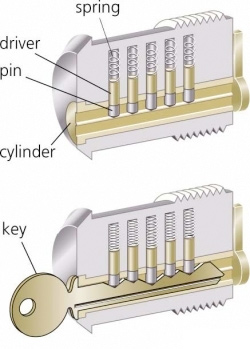A good question and one that varies hugely between different sizes and different manufacturers.Padlocks have what are known as ‘differs’, or the amount of unique padlocks within a batch. This means that after a certain number of locks are produced off the production line, they will begin to repeat. This is inevitable due to the way they are constructed.
Overview
Differ numbers are important for many reasons but mostly that you want to ensure that someone else is highly unlikely to have a key that fits your lock. I practice for an individual lock this is never really a problem since there are many differs in each set and most lock manufacturers use different key blanks that won’t even fit into each others padlocks.
However, it can be a problem where you get many of the same type of lock in one place. Schools are an example where you could have over 1000 lockers all fitted with the same standard issue padlock. In a situation like this you want at least 200 differs. Students are generally the biggest problem since they challenge themselves to find another lock with the same key. If they find one then the game often spreads like wildfire through the school. With at least 200 unique locks in a set then it is unlikely you’d find another lock that matches and, even if they did, there wouldn’t be many others, if at all.
High and Low Differs
Small locks have less differs than larger locks since they contain more pins. See the technical bit below. Cheap locks also have less differs than expensive locks. So from this you can deduce that buying small cheap locks for a batch of lockers is a bad idea. In our tests we have seen some have less than 15 differs, meaning that in batch of 100 locks, every lock would repeat at least 6 times. Not good.
Most top manufacturers (ABUS, Yale, Masterlock, Shield, Squire, Zone) will issue they differ numbers but rarely do they match up to these in practice. See Differ Testing below.
The Technical Bit
Each lock contains pins. This is called a pin tumbler mechanism. Each pin is aligned correctly when you insert the key and then allows the barrel to twist. If the pins are not aligned then the barrel will be prevented from twisting as the pin will get stuck in the side of the rotating barrel.
Each pin therefore has a number of different settings or sizes to make up a variety of differs or key combinations that will open the lock. To do this they split the pins at various places. If for example the pin had 5 different places it could be cut, and the lock barrel has 5 pins, then the total number of differs that lock could contain is 25. In a batch of 50 padlocks every lock would be repeated once on average. In practice the differ rates are a lot higher than this.
Differ Testing
Manufacturers will quote the differ number of their locks. This can be the technical differ or true differ. The technical differ refers to the actual number of differs in the pins and mechanism. However, some brands have their pins differences so close that they will still open each other. Therefore the technical differ is not of much use as it varies so much. True differ can only be calculated by testing a batch of 250 locks at least 3 times to take the average. At present we are the only organisation that does True Differ Testing.
The only brand we have found that have consistent true differs over the years is ABUS. Below are the quoted differs on a set of their brass padlocks:
15mm Padlock – 16 differs (3 pins)
20mm Padlock – 40 differs (3 pins)
30mm Padlock – 200 differs (4 pins)
40mm Padlock – 540 differs (5 pins)
50mm Padlock – 1000+ differs (5 pins)
From this we would only recommend using locks of 30mm or above for use on lockers.
